Film Review: The White Ribbon
According To Michael Haneke, The Kids (Plus The Parents And Basically Everyone Else In The Community) Are Not Alright


never mind.”

Latest Article|September 3, 2020|Free
::Making Grown Men Cry Since 1992


never mind.”
